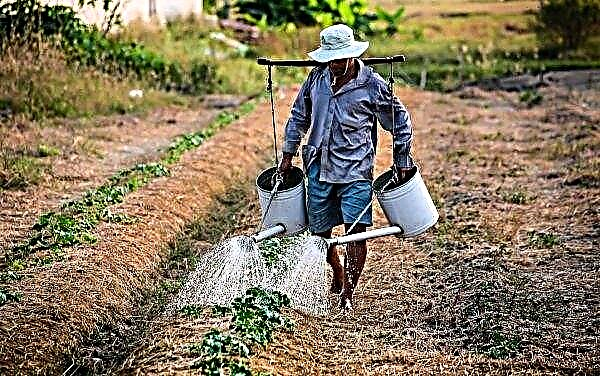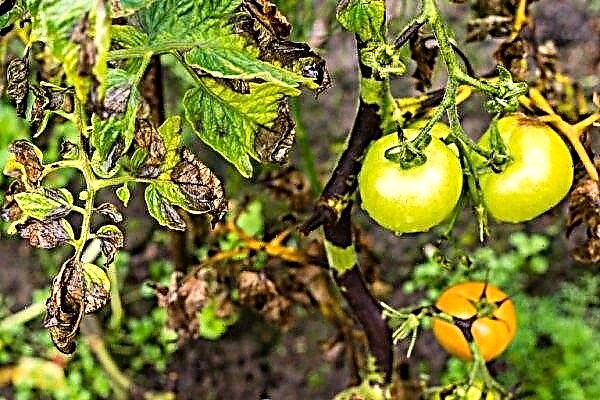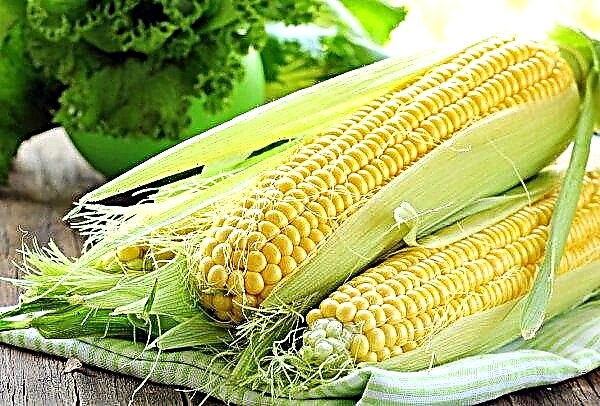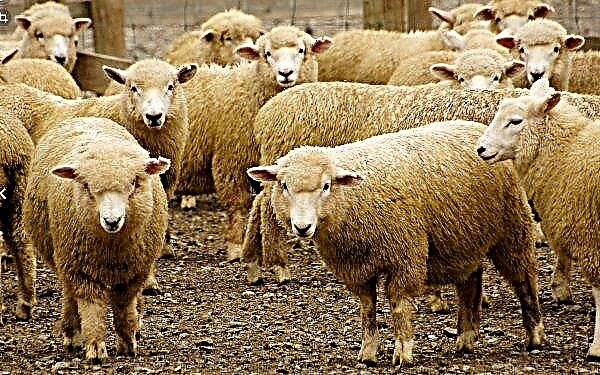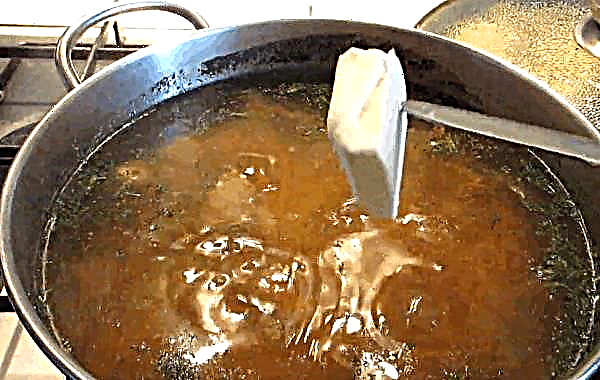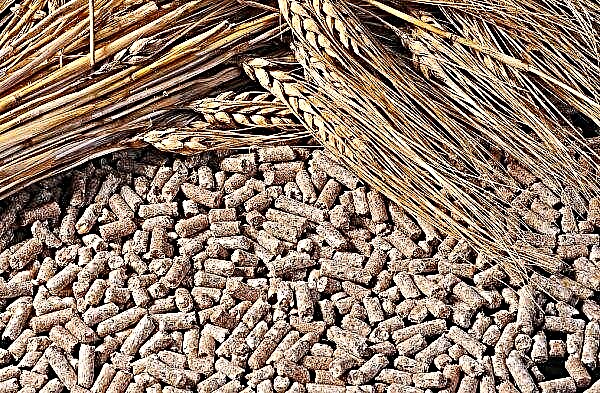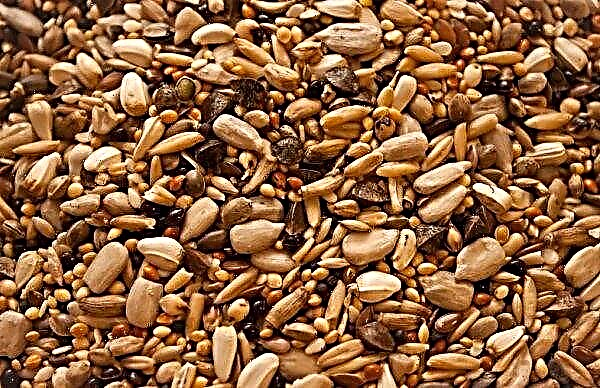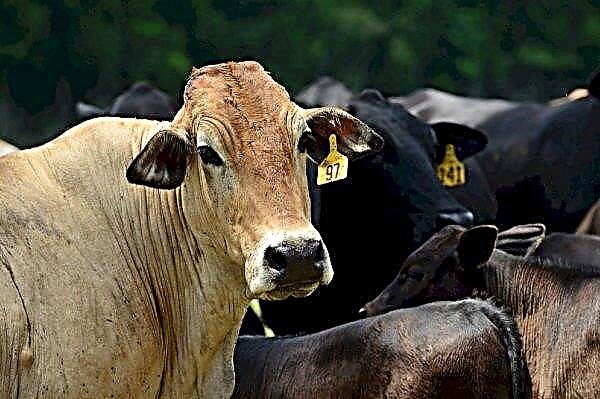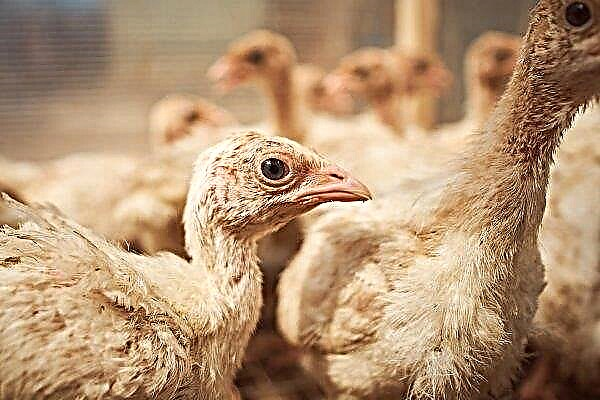Selection does not stand still, new varieties and varieties appear annually, but many gardeners always plant not only new products, but also old deserved pepper varieties that do not fail. This is exactly how the Pinocchio F1 hybrid is. We will get acquainted with this variety of pepper, its characteristics, the features of growing and caring for it, how to collect and store it.
Description and characteristics of the variety Pinocchio F1
It was received by the breeders of the vegetable experimental station. V.I. Edelstein (Moscow). It was registered as a variety in 1995 and is recommended for cultivation in the Central, Northwest and Central Black Earth regions.
This is an early variety, reaching technical ripeness in 88-100 days from the appearance of seedlings. It is suitable for cultivation both in the open, and in the closed ground. Medium resistant to tobacco mosaic virus, apical rot. Variety Pinocchio F1 tolerates strong winds, rainy and hot weather, can bear fruit when there is a lack of light.

Productivity
From each square meter, you can collect from 10.5 to 13.3 kg of fruits. Their marketability is about 98%.
Description of the bushes
It forms a strong bush of a semi-determinant type 0.7–1 m high. It has a weak branching - only 2–3 shoots, but looks spreading. The leaves are small, painted in dark green.
Did you know? In 100 g of fruits of Buratino F1 peppers, 204.5 mg of vitamin C is found. This more than doubles the daily requirement of a person for ascorbic acid.
Description of the fetus
In Buratino pepper, fruits grow up to 100–120 g in weight, about 17 cm long and 8 cm wide. They have a red color with silver tints and a cone-shaped elongated shape, small ribbing. The fruits are fleshy, juicy, wall thickness up to 4-5 mm. They have good taste, sweetish pulp, dense skin, excellent transportability, they can be stored for a long time. The solids content reaches 6.6%, sugar - 3.9%.
Advantages and disadvantages of the variety
- Hybrid Pinocchio has such advantages:
- early ripening;
- gives stable high yields;
- unpretentious;
- large fruits of presentation;
- good taste;
- high content of vitamins;
- suitability for conservation;
- transportable and well stored;
- resistant to disease;
- the bush does not require molding.
- The disadvantages include:
- somewhat simple taste;
- frequent need for garter;
- the inability to use their own seed material from their peppers.
Features of growing pepper
In the southern regions, the Buratino F1 pepper variety can be grown in open ground, and in all others in shelters and greenhouses. In both cases, the seedling method is used.
Preparing seeds for sowing
Seeds purchased by weight should be soaked in saline for 10 minutes (1 tbsp. L. Salt in 1 l. Of water). Empty seeds will emerge, and full seeds will sink to the bottom. It will be necessary to drain the water with the surfaced seed material, and rinse the remaining.
To increase the resistance, dry seeds can be hardened. To do this, in the daytime we keep them in a warm room (+ 20 ... + 22ºС), and at night we put them on the shelf of the refrigerator with a temperature of + 2ºС. This mode lasts 3 days.
Before planting, seeds must be decontaminated. The easiest way is to immerse them for 20 minutes in a light solution of potassium permanganate (10 g of powder in 1/2 liter of water). Then they should be washed.
For better germination, the seed material can be soaked in stimulants (Epin, Zircon) for 12 hours. Then dry by spreading on a natural piece of fabric. Instead of stimulants, you can use an ash solution that perfectly nourishes pepper seeds with the elements he needs. For this, 2 tbsp. ash insist day in 1 liter of water. Then the solution is filtered and the seeds are wrapped in it, wrapped in gauze for 5 hours. Then they are dried on the fabric. After soaking the seeds in stimulants and nutrient solutions, they are not washed.
Before planting in the ground, pepper seeds are recommended to germinate. To do this, they are wrapped in wet gauze and kept in a room with a temperature of +20 ... + 25ºС. It is necessary to monitor the moisture content of the gauze, and after 2-3 days the seeds will hatch.The selection of containers for seedlings
Best seedlings of pepper grow in a separate container. Seeds can be immediately sown in containers, where they will grow before planting, or can be planted in a common container, and then dive. Peppers can be grown in a common box, 10 cm deep. The distance between plants in a common container should be at least 6 cm.
As separate containers, you can use boxes, plastic cups, peat pots, cut plastic bottles and packs from under dairy products. They make drainage holes. You can buy pots for seedlings or cassettes.
Important! Individual containers for pepper should not be less than half a liter.
Seedlings that will be dived can first be sown in smaller dishes with a depth of 5 cm, and then, after the appearance of the second sheet, dive into individual dishes. It must have drainage holes.
Preparing land for seedlings
It is most convenient to buy ready-made universal soil in an agricultural store.
If you wish, you can make these mixes yourself:
- 2 parts of land from the beds, 2 parts of humus, 2 parts of peat and 1 part of sand;
- 2 parts of turf, 2 parts of peat (top), 1 part of humus or compost and ½ – 1 part of sand.

Sowing seeds for seedlings
Seeds are planted in the soil mixture to a depth of 1-1.5 cm. 1-2 seeds are planted in individual dishes, and then only one plant is left - the strongest one. Seeds with a distance of about 2 cm from each other are planted in a total capacity for a subsequent dive. The earth is moistened and the containers are covered with a film on top, which is removed daily for 20 minutes to ventilate and control the moisture content of the substrate.
The temperature before emergence should be maintained at + 25 ... + 28 ° C. When shoots appear, the film is removed and the containers with sprouts are transferred to a lit place. When there is enough heat, seedlings appear on the 5-7th day, and if there is not enough heat, then later.
Did you know? Capsicum culture was brought to us from the American continent, after its discovery by Columbus. In tropical areas, its wild species are still growing there.
Features seedlings care
The first few days from the appearance of seedlings, temperatures are kept within + 15 ... + 18 ° С so that the sprouts do not stretch. After 5 days, you can increase the temperature to + 20 ... + 25 ° C. Watering is carried out with warm, defended water under the root. This is best done in the morning. The soil should not dry out, but you do not need to fill the plants.
On bright sunny days, young seedlings are a little shaded by the hot rays of the sun. So that it does not stretch in one direction, it is recommended that containers with it be turned in different directions to the sun. About a month later, when a second leaf appears, peppers planted in a common seedling tank are dived into a separate bowl.
For pepper seedlings, top dressing is done at least two times:
- in the phase of 2-3 leaves or 2 weeks after the pick;
- one week before landing.

Two weeks before planting, the seedlings are tempered, taking to the balcony in the daytime. First, the seedlings are there for only a few hours, then this time is increased, and before planting, the plants already spend the night there. Plants are accustomed to the sun gradually and are first covered from direct rays.
Transplanting seedlings into the ground
Early varieties are transplanted into the soil at the age of 50-60 days. At this time, the plant should appear buds. The threat of frost should pass and the land on the beds (open or protected) should warm up to +14 ... + 16 ° С.
For planting, choose a sunny place on which pepper and other solanaceous crops did not grow before. The beds are prepared in advance from the fall. Organic matter is introduced into the ground during autumn digging. Sawdust, peat, and manure are closed in loams. In clay lands, in addition to this mixture, sand is added. In spring, they are fertilized with mineral complexes mainly with potassium and phosphorus.On 1 m²:
- 1 glass of ash;
- 1 tbsp. superphosphate;
- 1 table. potassium sulfate;
- 1 tsp. Urea.

If there is a threat of frost or a drop in temperature, the plantings are covered with lutrasil or other covering material.
Care after planting seedlings in the ground
Although Pinocchio F1 peppers are unpretentious, in order to get a good crop, he needs to ensure optimal care.
Watering and feeding
When caring for peppers, regular watering is necessary. After planting in the ground, watered at first every day with warm water, and then watering is reduced to 2 times in 7 days. With the onset of heat, watering can be enhanced.
Important! With a lack of watering, the bushes remain thin and poorly developed, and excess moisture can cause fungal diseases.
After landing in open ground, it is necessary to produce at least three top dressings:
- After planting in the soil after 14 days carry out the first application of fertilizers. A solution for irrigation under the root is prepared - 10 g of urea, 25 g of double superphosphate are taken for 10 l of liquid. 1 bush is about 1 liter.
- During flowering. Use a solution of boric acid at the rate of 1 g per 1 liter and spray the bushes. After 14 days, the bushes are recommended to be infused with nettle infusion.
- Education ovary. Root dressing is introduced - for 10 l of liquid, 5 g of urea and urea are taken, 10 g of double superphosphate. 200-300 g of such a solution is enough for one bush. You can fertilize with such a solution - 30 g of nitroammophos per 10 l of liquid.
When plants grow on soils that are not rich in nutrients, it is recommended to introduce organic fertilizers - infusion of manure or bird droppings.
It should be noted that peppers like good lighting. Therefore, the site should be well lit by sunlight, and the bushes should not obscure each other. In the southern regions, slight shading is permissible.
Loosening and hilling soil
After each watering, it is recommended to loosen the soil around the bushes. They also recommend that when the seedlings grow up to carry out the hilling of bushes. Such a procedure will contribute to the growth and, accordingly, the strengthening of the root system.
Important! Loosen the soil around the plant carefully, as the root system is located close to ground level.
It is also necessary to remove weed grass during loosening, which draws moisture and nutrients onto itself. From drying out, the soil can also be mulched with hay, sawdust, humus.
The formation of pepper bushes
Bushes of Pinocchio pepper F1 can not be formed, since it is not particularly branching. Pinching is carried out if necessary for molding in 1-3 stems. By pinching weak shoots, a lush and strong bush is formed. Be sure to remove the flower that forms first in the center of the bush. It should be noted that the plant in order to protect against gusts of wind, should be tied to a support, which is installed nearby. Usually, wooden pegs are used for this.
Disease and pest resistance
Pinocchio pepper is resistant to diseases such as vertebral rot, tobacco mosaic virus. With proper care, the plant is not afraid of any disease.
It is important to observe crop rotation. So, on a site where solanaceous previously grew, peppers are planted after 3 years. When growing peppers in greenhouse conditions, it is necessary to disinfect the soil and the greenhouse itself annually. For such preventive disinfections, copper sulfate or Bordeaux liquid is used, as well as the Fitosporin preparation.
To combat insect pests (aphids, ticks, slugs), chemicals such as Karbofos, Fitoverm, and Regent are used.In the suburban area, you can plant calendula, marigolds, garlic between rows of plantings to deter pests. Insects do not like the smell of these plants. You can also apply spraying with a solution of garlic, birch tar.
Against pest larvae, it is recommended to dig up the soil for the winter and remove the remains of vegetation from the site.
Harvesting and storage
The fruits are harvested from July until the cold snap. To increase the yield, it is recommended to remove peppers when technical ripeness is achieved. This allows other fruits to receive more nutrition.
To ensure long storage, you must adhere to certain conditions:
- Ripe peppers are better stored in the refrigerator in the vegetable section (temperature around + 2 ° C, humidity 90%). It is necessary to make sure that there are no spoiled copies, since they can cause the process of decay in other peppers. Under such conditions, these vegetables can be stored for 60–90 days.
- Green pepper can be stored at a temperature of +7 ... + 10 ° C and a humidity of 90–95%, that is, in the basement, cellar. Storage in such cases lasts up to 90 days.
- If you store green specimens at a temperature of more than + 10 ° C and a humidity of 91–95%, then the vegetables will ripen for about 26-30 days.
- For convenience and shelf life, it is better to place vegetables in wooden or plastic boxes, after wrapping each copy in paper sheets.
Did you know? Vegetable peppers have been grown since antiquity of Maya and the Aztecs. This vegetable was a symbol of the Aztec goddess of the hearth and volcanoes Kausholotl.
The sweet hybrid of Pinocchio pepper F1 gives stable yields of red fruits with a high content of vitamin C.

